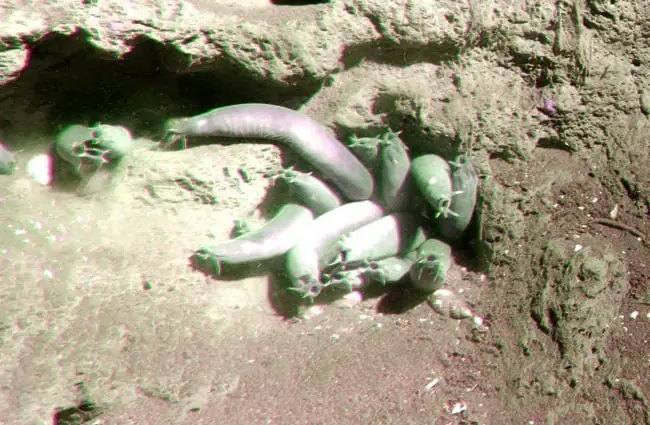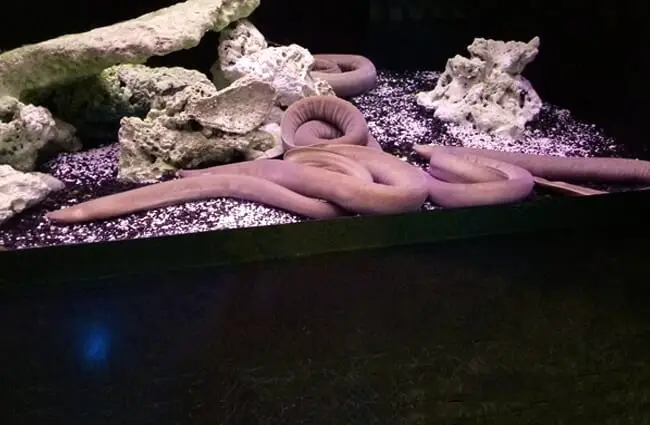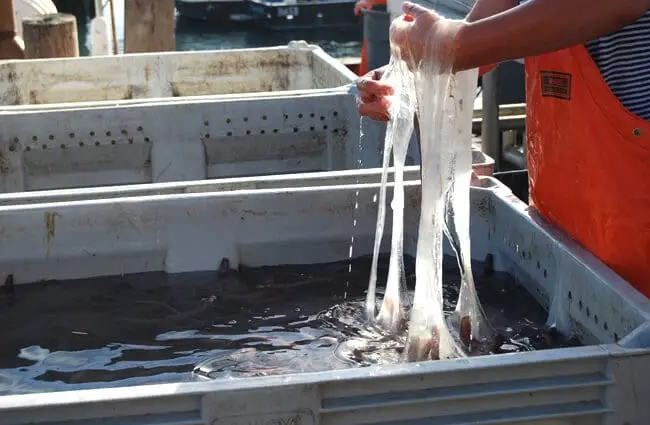Unveiling the Enigmatic Hagfish: An Ancient Mariner of the Deep
Deep within the ocean’s twilight zones, where sunlight barely penetrates and pressures are immense, thrives a creature that seems to defy the very definition of a fish. Often misunderstood and frequently overlooked, the hagfish is a living fossil, a testament to evolutionary resilience, and a vital, albeit slimy, component of marine ecosystems. Prepare to dive into the fascinating world of these jawless wonders, from their ancient origins to their remarkable adaptations and surprising interactions with our own world.

The Basics: What is a Hagfish?
At first glance, a hagfish might not win any beauty contests. These elongated, eel-like creatures are typically grey, pink, or purplish, with soft, scaleless skin. They lack jaws, a feature that immediately sets them apart from most fish we recognize today. Instead of a bony spine, they possess a flexible cartilaginous notochord, a primitive backbone. Their eyes are rudimentary, often covered by skin, suggesting that sight plays a minimal role in their deep-sea existence. Instead, they rely heavily on their keen sense of smell and touch, aided by several whisker-like barbels around their mouth.
Where to Find These Deep-Sea Dwellers: Hagfish Habitat
Hagfish are exclusively marine animals, inhabiting temperate and tropical waters across the globe. They are benthic creatures, meaning they live on or near the seafloor. Their preferred habitat ranges from relatively shallow coastal waters to the abyssal depths, sometimes found over 1,700 meters (5,600 feet) deep. They thrive in soft, muddy, or sandy substrates, where they can burrow to hide from predators or rest. If an animal lover were hoping to spot a hagfish in the wild, the best bet would be to observe deep-sea environments, perhaps through remotely operated vehicles (ROVs) or submersibles, as they are rarely seen near the surface. They are often attracted to carrion, so areas with decaying organic matter on the seabed are prime locations.

The Hagfish Diet: Nature’s Clean-Up Crew
Hagfish are primarily scavengers, playing a crucial role in the deep-sea ecosystem as nature’s clean-up crew. Their diet consists mainly of dead or dying marine animals, such as whales, fish, and invertebrates that sink to the seabed. They are incredibly efficient at locating carrion, using their highly developed sense of smell. Once they find a food source, they burrow into it, consuming the flesh from the inside out. They also prey on small invertebrates like worms and crustaceans, which they find by probing the sediment with their barbels.
The Slime Defense: A Sticky Situation for Predators
Perhaps the most iconic and astonishing feature of the hagfish is its ability to produce copious amounts of defensive slime. When threatened, specialized glands along its body release a protein that, upon contact with seawater, rapidly expands into a sticky, fibrous, and incredibly voluminous gel. This slime can clog the gills of potential predators, such as sharks, effectively deterring them. A hiker or diver who encounters a hagfish should observe from a distance and avoid touching it. While harmless to humans, the slime is incredibly difficult to remove and can quickly become an overwhelming mess. It is a remarkable adaptation, allowing a seemingly vulnerable creature to defend itself against much larger adversaries.

A Journey Through Time: Hagfish Evolution and Anatomy
An Ancient Lineage: The Jawless Wonders
For aspiring zoologists and students of evolutionary biology, the hagfish offers a direct window into the distant past. These creatures belong to the class Myxini, a group of jawless fish that represent one of the oldest lineages of vertebrates, or at least vertebrate relatives. Their fossil record extends back over 300 million years, with some estimates placing their origins even further back, suggesting they have changed very little over vast geological timescales. They are often considered sister groups to vertebrates, sharing a common ancestor with lampreys and all other jawed vertebrates. Studying hagfish provides invaluable insights into the early evolution of chordates and the transition towards the more complex vertebrate body plan.
Unique Anatomical Adaptations
The hagfish body is a marvel of adaptation for its deep-sea scavenging lifestyle. Beyond their lack of jaws and rudimentary eyes, they possess several other unique features:
- Notochord: Instead of a vertebral column, they retain a flexible notochord throughout their lives, providing structural support.
- Accessory Hearts: In addition to a main heart, hagfish possess several accessory hearts located throughout their body, helping to circulate blood efficiently in a low-pressure environment.
- Single Nostril: They have a single, median nostril that connects to the pharynx, allowing them to “smell” water that passes through their gills.
- Barbels: The sensory barbels around their mouth are crucial for locating food in the dark depths.
- Slime Glands: Hundreds of specialized glands along their flanks produce the famous defensive slime.
- Tongue with Keratinous Teeth: Despite lacking jaws, their muscular tongue is equipped with two rows of keratinous “teeth” that they use to rasp flesh from carrion.

Life Cycle and Ecological Role
Reproduction: A Mystery Unraveling
The reproductive habits of hagfish remain one of their most elusive secrets, making them a fascinating subject for research. What is known is that some species exhibit hermaphroditism, meaning individuals can possess both male and female reproductive organs, sometimes even changing sex during their lifetime. Fertilization is external. Females lay a relatively small number of large, yolky eggs, often encased in a tough, leathery shell with hook-like anchors that allow them to attach to the seabed or other structures. There is no larval stage; young hagfish hatch as miniature versions of the adults, a direct development pattern that is unusual among fish. This low fecundity and direct development suggest a strategy for survival in a stable, resource-limited deep-sea environment.
Ecosystem Contributions and Interactions
Hagfish are indispensable members of deep-sea ecosystems. Their primary contribution is as detritivores and scavengers. By consuming carrion that sinks from the upper ocean layers, they prevent the accumulation of organic matter on the seabed, facilitating nutrient cycling and preventing anoxic conditions. This role is critical for maintaining the health and balance of deep-sea communities. They interact with other animals primarily through competition for food, though their unique feeding strategy and slime defense often give them an advantage. While they are prey for some larger deep-sea predators, their slime makes them a challenging meal.

Hagfish and Humanity: From Research to Resources
Interaction with Humans and Cultural Significance
Hagfish have a surprisingly diverse range of interactions with human culture and industry. In some parts of the world, particularly East Asia, hagfish are considered a delicacy and are fished commercially. Their tough, leathery skin is also highly prized and processed into “eel skin” leather, used for wallets, belts, and other accessories. This industry has raised concerns about the sustainability of hagfish populations in certain areas. Beyond consumption and commerce, hagfish are invaluable subjects for scientific research, particularly in fields like evolutionary biology, biomechanics (studying their slime), and physiology, offering insights into ancient vertebrate forms and unique biological processes.
Caring for Hagfish in Captivity: A Zookeeper’s Guide
Caring for hagfish in a captive environment presents unique challenges and requires specialized knowledge, making them a fascinating species for zookeepers. The primary tasks involve replicating their deep-sea habitat and managing their distinctive biology:
- Water Quality: Maintaining pristine, cold, and well-oxygenated saltwater is paramount. Parameters such as salinity, temperature (typically 4-12°C), pH, and ammonia/nitrate levels must be rigorously monitored and controlled to mimic their natural deep-sea environment.
- Substrate: A deep layer of soft, fine sand or mud is essential, allowing them to burrow, which is a natural behavior for security and rest.
- Diet: Replicate their scavenging diet with regular offerings of thawed, high-quality fish or invertebrate carrion. Care must be taken to remove uneaten food promptly to prevent water degradation.
- Tank Design: Tanks should be spacious enough to accommodate their burrowing and swimming behaviors, with minimal strong currents.
- Slime Management: This is perhaps the most critical aspect. Hagfish will produce slime when stressed. Zookeepers must minimize stressors and be prepared for rapid slime production. This often requires specialized filtration systems or quick removal protocols to prevent the slime from fouling the water and potentially harming other tank inhabitants. Avoid sudden movements, bright lights, or overcrowding.
- Handling: Direct handling should be minimized. If necessary, use appropriate tools and ensure the hagfish is returned to its burrowing substrate quickly to reduce stress and slime production.
By understanding and addressing these specific needs, zookeepers can provide a suitable environment for these ancient mariners, allowing for public education and continued scientific study.
Fascinating Facts About Hagfish
Dive deeper into the world of hagfish with these intriguing tidbits:
- “Eel Skin” Misnomer: Despite being called “eel skin” leather, the material actually comes from hagfish, not true eels.
- Knotting Behavior: Hagfish can tie themselves into an overhand knot, which they use to escape from predators by scraping off slime, or to gain leverage when tearing flesh from carrion.
- Osmoconformers: Unlike most marine vertebrates that regulate their internal salt concentration, hagfish are osmoconformers, meaning their body fluids have a similar salt concentration to the surrounding seawater.
- Rudimentary Eyes: Their eyes are so basic that they can only detect light and dark, not form images. Their other senses compensate for this.
- No Scales: Their smooth, scaleless skin is another primitive feature.
- Remarkable Survival: They can survive for extended periods without food, a useful adaptation for a scavenger in a resource-scarce environment.
- Slime Strength: The protein fibers in hagfish slime are incredibly strong and elastic, inspiring research into new biomaterials.
- Ancient Ancestry: They are one of the few surviving lineages of jawless fish, providing a living link to the earliest vertebrates.
- Multiple Gills: Most species have 5-16 pairs of gill pouches, rather than the single gill slit seen in many fish.
- No Paired Fins: They lack the paired pectoral and pelvic fins common in most fish, moving instead with an eel-like undulation.
Conclusion: Appreciating the Unsung Heroes of the Deep
The hagfish, with its unassuming appearance and peculiar habits, stands as a remarkable testament to the power of evolution and survival. From its ancient lineage to its astonishing slime defense and vital role as a deep-sea scavenger, every aspect of this creature’s life is a story of adaptation and resilience. They are not just biological curiosities; they are crucial components of marine ecosystems, subjects of groundbreaking scientific research, and a reminder of the incredible diversity hidden beneath the waves. As we continue to explore and understand our oceans, the hagfish reminds us that even the most unusual inhabitants play an indispensable role in the grand tapestry of life on Earth. Let us appreciate these unsung heroes of the deep, ensuring their continued survival for generations of students, zoologists, and curious minds to come.

![Red Angus Closeup of a beautiful Red Angus cowPhoto by: U.S. Department of Agriculture [pubic domain]https://creativecommons.org/licenses/by/2.0/](https://animals.net/wp-content/uploads/2020/03/Red-Angus-4-238x178.jpg)




![Red Angus Closeup of a beautiful Red Angus cowPhoto by: U.S. Department of Agriculture [pubic domain]https://creativecommons.org/licenses/by/2.0/](https://animals.net/wp-content/uploads/2020/03/Red-Angus-4-100x75.jpg)

